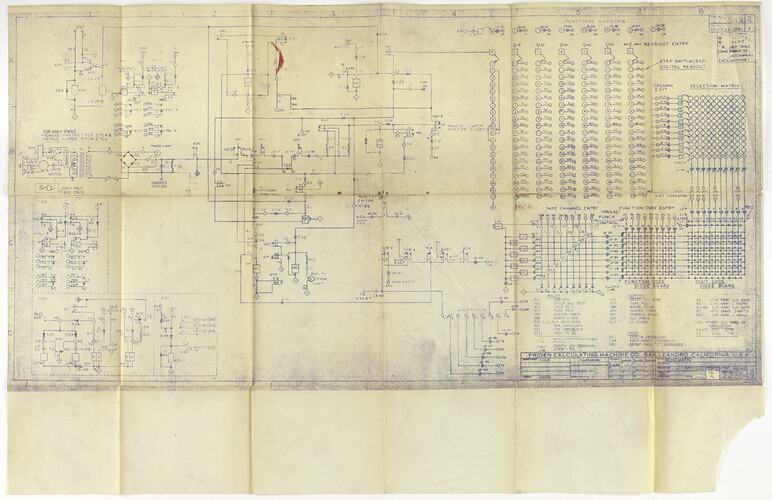Summary
A Blueprint for the Schematic Wiring of a Flexowriter. Part Number 223549 Used by the donor in his capacity as maintenance engineer for Friden Flexowriter equipment. He had responsibility for the Flexowriters used with CSIRAC at the University of Melbourne.
Physical Description
A single leaf paper. It has been folded 7 times for storage purpose. Systematic diagram on left side of print; key / notation in right. Object details recorded in bottom right and top right corners. Carbon copy.
Significance
This item is part of a collection, which provides an important insight into the working of CSIRAC, Australia's first computer, the fourth in the world and now one of Museum Victoria's most significant technology artefacts. CSIRAC was custom built but one of its few commercially made peripheral components was the Flexowriter. This peripheral data and program preparation unit was introduced to CSIRAC's operation in 1962. A commercial 5 hole paper tape reader and punch had already been hooked up to CSIRAC in the late 1950s. The 5 hole paper tape equipment was introduced to bring CSIRAC's input and output format into line with the current standard of 5 hole paper tape being used by most of its organisational users, such as CSIRO. CSIRAC was originally built to use 12 hole tape, which was later used in tandem with the 5 hole tape. The Flexowriter was used to create data and program input for CSIRAC by punching out 5 hole paper tape. It could also read these tapes and produce a typed 'English language' version of the information represented by the holes in the tape. It could also duplicate punched paper tapes. By understanding how this piece of equipment worked, we have a broader understanding of CSIRAC's operation and its necessary evolution in the rapidly changing world of computing in the 1950s and 60s.
The collection is also important because it is the tool kit of the man who maintained Friden Flexowriters in Australia, and hence tells a story of 'working life'. The items in this collection were carried with the donor every day, as he travelled around Australia to the many sites that used Flexowriters in the 1950s and 60s. In conjunction with an oral history, this collection will tell the story of a career in an era when communications technology was still largely electro-mechanical and when loyalty to one's employer was de riguer. The donor stayed with the company that sold and serviced Flexowriters for his whole career, moving on to other products when the Flexowriter became obsolete.
Finally, the tools link to the story of the company that was licenced to sell and service Friden Flexowriters and hence to the early development of companies that provided technological products and support to the emerging computer market
More Information
-
Collecting Areas
-
Acquisition Information
Donation from Mr Tony Climpson, 17 Jul 2003
-
Publisher
-
Date used
-
Inscriptions
Top Right: 223549 /4 E45OCT-23-2051 / E Bottom Right: FRIDEN CALCULATING MACHINE CO. SAN LEANDRO. CALIFORNIA. U.S.A. 223549
-
Classification
Computing & calculating, Digital computing, Reference materials
-
Category
-
Discipline
-
Type of item
-
Object Measurements
862 mm (Length), 557 mm (Width)
-
Keywords
